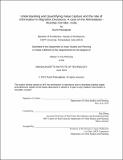| dc.contributor.advisor | Siqi Zheng. | en_US |
| dc.contributor.author | Palavajjhala, Rushil. | en_US |
| dc.contributor.other | Massachusetts Institute of Technology. Department of Urban Studies and Planning. | en_US |
| dc.coverage.spatial | a-ii--- | en_US |
| dc.date.accessioned | 2020-02-28T20:51:40Z | |
| dc.date.available | 2020-02-28T20:51:40Z | |
| dc.date.copyright | 2019 | en_US |
| dc.date.issued | 2019 | en_US |
| dc.identifier.uri | https://hdl.handle.net/1721.1/123934 | |
| dc.description | This electronic version was submitted by the student author. The certified thesis is available in the Institute Archives and Special Collections. | en_US |
| dc.description | Thesis: M.C.P., Massachusetts Institute of Technology, Department of Urban Studies and Planning, 2019 | en_US |
| dc.description | Cataloged from student-submitted PDF version of thesis. | en_US |
| dc.description | Includes bibliographical references (pages 126-131). | en_US |
| dc.description.abstract | The Thesis attempts to unpack how rural residents across India make decisions to migrate to urban centers in the Ahmedabad -Mumbai corridor and analyze if those decisions are concomitant with helping them achieve their migration intents. The study uses both qualitative and quantitative methods to analyze 52 origin -- destination pairs of migration. The qualitative methods, based on 52 field interviews, help understand the nuances of how and why people migrate. In analyzing patterns here, the study also heavily references the existing literature to establish departure points for quantitative studies. Basing itself on the model that these migration decisions are a trade-off between the wage differential and the social cost of being uprooted from one's native place, it attempts to quantify the gain and see if the gains proportionately increase with increased compromises on the migrant's social ties to their native place. It relies on geo-spatial analysis and several regression models to analyze the above mentioned phenomenon and offer a nuanced understanding of where value is captured/ lost in the process of migration. Finding that housing rents significantly offset wage differentials, a key part of understanding the value capture has been achieved through an analysis of housing rental data. The data analysis includes data collected via web-scraping and the gathering of about 25,000 datapoints, as well as rental and income data from 52 field interviews of migrants -- primarily working in the informal sector. In concluding its findings and analysis, the Thesis finds that solving information asymmetry , addressing integration of migrants into urban life whilst also maintaining their social ties with their native places, and state subsidies/ policies for cost effective and flexible rental housing may be the most critical pieces to improve the socio-economic mobility of migrants. The Thesis forms a basis for an entrepreneurial venture 'Bandhu'- by the author. | en_US |
| dc.description.statementofresponsibility | by Rushil Palavajjhala. | en_US |
| dc.format.extent | 131 pages | en_US |
| dc.language.iso | eng | en_US |
| dc.publisher | Massachusetts Institute of Technology | en_US |
| dc.rights | MIT theses are protected by copyright. They may be viewed, downloaded, or printed from this source but further reproduction or distribution in any format is prohibited without written permission. | en_US |
| dc.rights.uri | http://dspace.mit.edu/handle/1721.1/7582 | en_US |
| dc.subject | Urban Studies and Planning. | en_US |
| dc.title | Understanding and quantifying value capture and the role of information in migration decisions : a case of the Ahmedabad-Mumbai Corridor, India | en_US |
| dc.title.alternative | Case of the Ahmedabad -Mumbai Corridor, India | en_US |
| dc.type | Thesis | en_US |
| dc.description.degree | M.C.P. | en_US |
| dc.contributor.department | Massachusetts Institute of Technology. Department of Urban Studies and Planning | en_US |
| dc.identifier.oclc | 1140204941 | en_US |
| dc.description.collection | M.C.P. Massachusetts Institute of Technology, Department of Urban Studies and Planning | en_US |
| dspace.imported | 2020-02-28T20:51:39Z | en_US |
| mit.thesis.degree | Master | en_US |
| mit.thesis.department | UrbStud | en_US |
